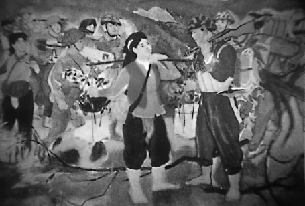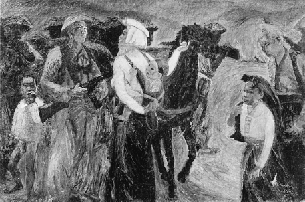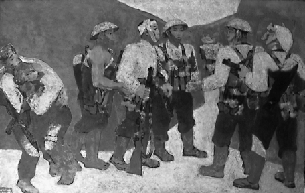THE CREATION OF A “NATIONAL
REVOLUTIONARY PAINTING” TRADITION
Westernstyle painting, or oil painting on canvas as it is known in the West, first appeared in Vietnam at the turn of the twentieth century, during the French colonial period, when artists came to Indochina from the me´tropole with their easels and palettes to paint the “exotic” Asian landscape. Victor Tardieu (1867–1937), an artist who had won a competition for painting a mural at the Universite´ Indochinoise in Hanoi, decided to establish an art academy in the colony to train local artists and artisans to become professional painters. In 1925, the Ecole des Beaux Arts d'Indochine (EBAI) was founded, and some twenty students enrolled. Most of the students were from local upperclass educated Hanoi families. A couple of students came from Cambodia and Laos, along with a few colonial residents. Classes in composition, anatomy, perspective, painting, and drawing were held in conjunction with a few classes in “indigenous” arts, painting on lacquer and silk.
The EBAI remained open until the 1945 Japanese coup against the French colonial government forced it to close down. Over the course of
The painters who followed To Ngoc Van to Viet Bac fell into two groups. In one were those who had already graduated from the EBAI prior to its closing and enlisted in the army out of patriotic duty serving as illustrators and/or revolutionary fighters. The second group consisted of painters who had not yet begun to study painting and, having joined the revolution, decided to study art simultaneously. The students who studied art in Viet Bac for the first time were given a diploma with the emblem of the Khoa Khang Chien.
The new school remained in operation for nine years. In 1954, after the victory over the French at Dien Bien Phu and the establishment of the Democratic Republic of Vietnam, it reopened in Hanoi. From 1954to 1986, the thirtysome artists who graduated from this class were seen as having contributed some of the most important works of art in the history of Vietnamese modern painting. They were accorded recognition on a par with the soldiers who fought in battle, given certificates of praise, and, in the case of To Ngoc Van himself, awarded the title of “revolutionary hero” (anh hung). To Ngoc Van died of injuries he suffered at the battle of Dien Bien Phu and was subsequently honored as a “revolutionary martyr” who sacrificed his life (hi sinh) for the revolutionary cause. Concurrently, his contemporaries named him Vietnam's greatest artist. However, the current generation of artists and art critics claim he was given the title not so much for his artistic talent but, rather, for having died fighting for his country.
For nearly four decades, the Resistance Class painters produced paintings of soldiers, combat heroes, women warriors, and the good deeds of the army along with more conventionally patriotic landscapes and rural scenes. These works, intended to be accessible to the masses,
The changes advocated by the current generation of artists in Vietnam are more easily understood if we examine the origins of the criteria created by the National Arts Association for selecting works of art worthy of the label “heroic,” “revolutionary,” or “national.” The selection the artists who were to receive the greatest exposure in the public eye was based primarily on political affiliation or personal participation in the nation's struggles against foreign imperialism. But several thematic and stylistic criteria were also established to determine the acceptability of the works of art to be displayed in public exhibitions. One of these revolved around the question of “national character” (tinh dan toc). The term was first used by Ho Chi Minh around the time of the August Revolution in 1945 to define the goals of the cultural policies established by the Democratic Republic of Vietnam. Ho Chi Minh had wanted art and literature to express the spirit of the Vietnamese people. He used the expression dan toc, meaning “nationality,” “nation,” or “national,” to describe the people of Vietnam, and the phrases tinh dan toc and van hoa dan toc to describe the “national character” and the “national culture” of the Vietnamese people.[2] The term was again used in the context of literature to define that which best expressed the qualities that the prevalent political discourse desired to associate with the nation or “Vietnameseness.” In the visual arts, it was coined by the Communist
Artists did not always grasp the concept of “national character.” Nor did cultural politicians define it in clear terms. Consequently, many artists chose to ignore this issue, leaving it to the viewer or the judges at the national art exhibitions to decide whether their work contained national character. Still, they were obligated to include aspects of what they perceived to be an acceptable theme or style in their work in order to receive recognition from the Arts Association.
In 1962, at the second congress of the Arts Association, an attempt was made to define the components of national character to provide specific guidelines for artists to follow in the making of their artworks. No concise definition was drawn, but the general parameters of the issue were made clear. According to one definition, “national character is the way of life and expression of a community of people who live together over long periods of time.”[4] Elsewhere, it was described as the “most natural element that constitutes humankind. So natural, in fact, that it defies all definition.”[5] The general understanding of national character was that it exemplified the spirit of the Vietnamese people in their struggle for independence, their daily work, and their ancient historical culture. Daily life, history, and “traditional” culture were the themes that were considered “beautiful” and “true” by the Arts Association and therefore deemed to be most representative of Vietnamese character.[6] The Communist Party's definition of daily life, history, and tradition did not always coincide with artists'understanding of those terms. Often, artists who thought they had displayed national character in their work were surprised to find out that their painting was not accepted by the Arts Association. Le Thi Kim Bach (born in 1938; student at the Hanoi College of Art from 1957 to 1960 and at the Soviet National University of Fine Arts in Kiev from 1961 to 1967) had one of her paintings rejected from a national art exhibition because, she said, the subject of her work, an old peasant woman, seemed overly sad.[7]
Paintings that represented farmers toiling in the fields, soldiers going to the front, or factory workers handling machinery were considered to contain national character, as were paintings that depicted historical figures, war heroes, and legendary independence fighters. But, if there was any suggestion of misery or violence in association with these images, the painting would be dismissed as unpatriotic. In his essay on Marxism and Vietnamese culture, Truong Chinh, secretary-general of
In the early 1960s, the regulations governing Arts Association artists were particularly strict and rigidly enforced. Several incidents involving artists and writers in the late 1950s had caused the Communist Party to pay close attention to the production of paintings and sculpture to ensure that artists were not going against the rules set by the Arts Association for the public display of artworks. The incidents in question involved a group of writers and artists who, at the first meetings of the Writers Association in 1956, had demanded greater freedom of expression and creative rights. These writers and artists were in fact asking to be allowed to produce “art for art's sake,” a notion that went against Ho Chi Minh's requirement for artists to follow the Maoist notion of “art for the service of the people.”[11] After publishing four issues of two art and literature journals entitled Humanism (Nhan Van) and Masterpieces (Giai Pham), several of the contributors were severely punished and sent to prison for “betraying the interests of the Communist Party, the Nation and the people of Vietnam.” The painters Nguyen Sy Ngoc (1919–90; student of the EBAI from 1939 to 1944) and Nguyen Sang (1923–88; student of the EBAI from 1940 to 1945) were directly affected by their involvement in this affair. Nguyen Sy Ngoc was sent to a labor camp for two years, and Nguyen Sang was barred from employment with the Arts Association.[12]
The other artists and writers involved were also banned from their previous positions and only gradually reintegrated into the artistic mainstream. The artists and writers involved in the criticism of the
In order to understand the role of “marginality” or “dissent” in the 1960s and 1970s, it is helpful to examine in further detail the differences between works of art that were considered “acceptable” and those that were not. One example of “acceptable” illustrations of “national character” is a painting by Mai Van Hien (born in 1923, student at the EBAI from 1943 to 1945) entitled Meeting (Gap Nhau, 1954; fig. 4.1). The painting was praised when it was exhibited at the first National Art Exhibition in 1955 because the subject of a soldier meeting a peasant woman illustrates the idea of community and solidarity between the army and the common people. In the painting, a soldier converses with a woman on the Dien Bien Phu Trail who has visibly helped to carry provisions for the soldiers. On her yoke are two camouflaged baskets that she apparently has been carrying for some time, as her bare feet and rolledup trousers indicate. The mood of the painting is reflected in the artist's simple descriptive style, which lends itself well to its content. The soldier and the woman appear friendly toward each other: the soldier is relaxed, his rifle is casually thrown over his shoulder, far from posing any threat to the woman, and the woman is smiling and concealing

Figure 4.1. Mai Van Hien, Meeting (Gap Nhau), gouache on paper, 1954. Photograph by Nora A. Taylor, courtesy of the artist.
In devising the scene of a meeting between a soldier and a peasant woman, Mai Van Hien was in effect describing the policy of integration of ethnic minorities and people from the countryside into the Vietnamese “nation” after independence from French colonialism. The feeling of camaraderie and equality between soldiers and peasants and between men and women as suggested in his painting also coincided with the goals of socialism outlined by the Communist Party to assimilate people from all classes and create a homogeneous society. Meeting was considered to contain “national character” because it illustrated one of the ideals of socialization and nationbuilding, which was to create a harmonious community. It also followed what Truong Chinh considered was “correctly expressing the feelings of the masses that are pure, sincere and exceedingly warm.”[15]
In contrast to Mai Van Hien's painting is a work that was initially rejected by the Arts Association: The Enemy Burned My Village (Giac Dot Lang Toi, 1954; fig. 4.2) by Nguyen Sang. In this painting, a

Figure 4.2. Nguyen Sang, The Enemy Burned My Village (Giac Dot Lang Toi), oil on canvas, 1954. Photograph by Nora A. Taylor, courtesy of National Museum of Fine Arts, Hanoi.
In another work, Joining the Communist Partyat Dien Bien Phu (Ket Nap Dang trong Tran Dien Bien Phu, 1963; fig. 4.3), the same artist sets up a conflict between patriotic theme and means of execution. He has used a particularly severe way of representing his figures, drawing them with angular lines, enlarged limbs, and blank features. The composition is centered on the hand of the party officer who reaches out to the soldier seeking admission. Although the gesture seems welcoming, the look on the soldier's face is cold and dispassionate. The wounded soldier appears anxious and lacking in enthusiasm. His expression may betray his doubt or apprehension at joining the party. The soldier behind

Figure 4.3. Nguyen Sang, Joining the Communist Partyat Dien Bien Phu (Ket Nap Dang trong Tran Dien Bien Phu), lacquer on wood, 1963. Photograph by Nora A. Taylor, courtesy of National Museum of Fine Arts, Hanoi.
While these two paintings by Nguyen Sang were never criticized directly, they were rejected from national art competitions. Criticism or rejection from national art competitions often meant that the work had been placed before an audience of workers and soldiers who, in the absence of any other formal criterion, were simply asked to decide how closely the subjects of the paintings resembled their habitat, moods, or customs. Sometimes, in lieu of a direct criticism, a humiliation campaign was initiated. Letters from workers and soldiers who found the work in question to be “untruthful” or “inaccurate” were published in newspapers. These letters were aimed at discrediting the author of the work in question, for if the masses did not understand it, then it was considered too “obscure” and therefore unacceptable.[16] Nguyen Sang had painted both of these paintings hoping for a subsidy from the Arts Association, and although the National Museum of Fine Arts eventually purchased the two works, they were not displayed until shortly before his death in 1984. When Nguyen Sang contributed drawings and poems to the Humanism and Masterpieces journals, his name was put on a
The rejection and subsequent acceptance of Nguyen Sang's views of history illustrate not only the fluctuations in the definition of “national character” but also the changing attitudes toward war and revolution in recent times. Nguyen Sang's vision is no longer threatening to authorities as they have gradually come to terms with the harsher realities of those years. Whereas in the past, as Mai Van Hien's painting illustrates, virtues of heroism and solidarity were considered the only legitimate representations of the struggle for independence, feelings of pain and apprehension have recently become equally acceptable.